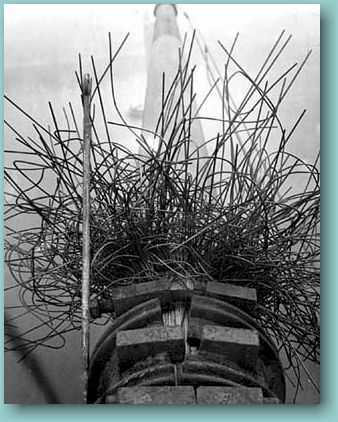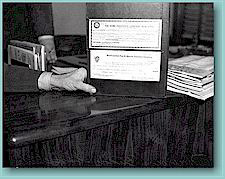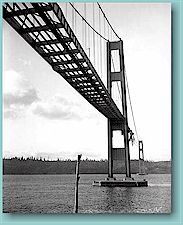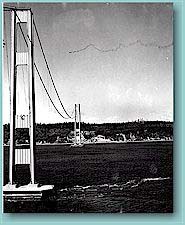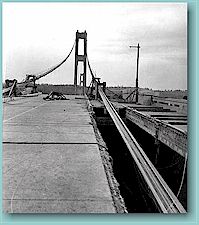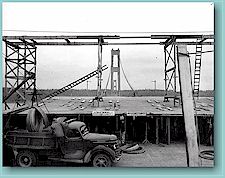History of the Tacoma Narrows Bridge
|
|
Pt. 5: The Aftermath
The following images and text detail the aftermath of Tacoma Narrows Bridge. Links to further pages on the Introduction, Construction, Opening, Collapse, and Reconstruction are available at the bottom of the page. Text sources are listed in the bibliography at the end of the Reconstruction section. Image sources are described in the captions accompanying the images. The images are the exclusive right of the cited institutions (the University of Washington Libraries Special Collections Division and the Museum of History and Industry, please contact them for reproduction permission.
For additional images and documents relating to the history of the Tacoma Narrows Bridge, see the Tacoma Narrows Bridge Collection on the UW Libraries Digital Collections website.
The day after the Tacoma Narrows Bridge collapsed newspapers were full of accounts. Most national newspapers and magazines ran stories on the collapse along with pictures taken by those who had witnessed the scene.
|
Headline from the Tacoma News Tribune, November 8, 1940. PH Coll. 290.149 University of Washington Libraries. Special Collections Division. Reprinted with permission from The News Tribune (Tacoma, WA) |
|
|
The bridge, which was insured with 22 policies from individual insurance companies, was claimed as a total loss. 80% or $5,200,000 of the structure’s valuation was covered by these policies.
There was news of fraud in connection with one of the policies. Hallett R. French, an agent for the Merchants Fire Assurance Company, was charged with grand larceny for withholding premiums on $800,000 worth of insurance. By and large however, the insurance claims were met and the funds put aside to help build the new bridge.
|
[Show image] Cable and broken concrete resulting from the collapse of the Tacoma Narrows Bridge, November 1940. Seattle Post-Intelligencer Collection, PI- 20798. Courtesy of the Museum of History and Industry. |
Slideshow |
|
[Show image] Five men walk to the collapsed central span of the Tacoma Narrows Bridge. PH Coll. 290.57 University of Washington Libraries. Special Collections Division. |
|
|
[Show image] Cable stripped by the collapse of the Tacoma Narrows Bridge, November 16, 1940. Bashford-Thompson Commercial Photographers PH Coll. 290.61 University of Washington Libraries. Manuscripts, Special Collections, University Archives Division. |
|
|
[Show image] Unidentified man looking through broken wires of the Tacoma Narrows Bridge, November 16, 1940. James Bashford Press Photos. PH Coll. 290.60 University of Washington Libraries. Manuscripts, Special Collections, University Archives Division. |
|
|
In the aftermath engineers on the project maintained that they had known the bridge was not stable. They felt that the bridge’s collapse was due entirely to improper shape and not improper strength.
Clark Eldridge, chief engineer for the bridge, felt that the federal money-lending agencies’ ‘insistence’ that the bridge be designed by an eastern firm led directly to the bridge’s unsound design.
“We had a tried-and-true, conventional bridge design,” Eldridge said. “We were told we couldn’t have the necessary money lenders.” (“U.S. Loaning Agents held Insistent on Own Design: Eldridge Declares Local Experts Demanded ‘Tried-and-True’ plan of much more stable construction,” Seattle Times, November 8, 1940)
|
|
Eldridge further maintained that Washington State Highway Department engineers had pointed out that the solid side girders would act like sails unlike the traditional open truss design that allowed wind to pass through.
The consulting designer, Leon Moisseiff felt the fall occurred because engineers did not know enough about aerodynamics, and that lack of funds had forced the building of a bridge unprecedently narrow for its length.
An investigative board, appointed by the Washington State Toll Bridge Authority to minutely examine the wreckage as well as determine the cause of collapse and estimate the cost to rebuild it, reported in March 1941 that the cause could not be identified until the wreckage had been torn down and studied.
On June 26, 1941 the board came back with their conclusions about the cause of the collapse.
|
Slideshow |
|
[Show image] Headline from the Engineering News-Record, November 14, 1940. Pierce County-Tacoma Narrows Bridge Pamphlet File N 979.744 University of Washington Libraries. Special Collections Division. |
|
[Show image] Headline from the Seattle Post-Intelligencer, March 14, 1941. Pierce County-Tacoma Narrows Bridge Pamphlet File N 979.744 University of Washington Libraries. Manuscripts, Special Collections, University Archives Division. |
Their report stated that the primary reasons for failure were the general proportions of the bridge and the type of girders and floor. The bridge was not stiff enough and didn’t have the sturdiness necessary to withstand the fluctuating winds of the Narrows.
Further, the solid girders made the bridge sensitive to wind forces that had been previously considered unimportant. The specific cause of the bridge’s fall was the slippage of the center cable band on the north cable due to forces it wasn’t strong enough to resist.
|
|
Another board, appointed by the Federal Works Agency (FWA), correlated the conclusion saying that the failure was caused by wind that reacted to the flexible nature of the bridge and its relative inability to absorb dynamic forces.
The cable band on the north side of the bridge slipped and allowed the bridge to begin twisting from side to side. This caused the suspending cables to break, allowing the center span to fall.
|
|
The approaches sagged, resulting in bending and over-stressing the towers and the approaches. Both boards felt that repair of the bridge was not possible. The wreckage would have to be dismantled and a new bridge built on the undamaged piers.
Discussions of the methods to be used in deconstructing the bridge were halted in December 1941 with the United States’ entrance into World War II. Steel supplies were redirected towards the war effort effectively putting reconstruction on hold until after the war.
|
Slideshow |
|
[Show image] Girders being removed from the collapsed Tacoma Narrows Bridge during salvage operations, January 1941. Seattle Post-Intelligencer Collection, PI- 20800. Courtesy of the Museum of History and Industry, Seattle. |
|
[Show image] Workman using cutting torch to disassemble the Tacoma Narrows Bridge during salvage operations, ca. 1941. Seattle Post-Intelligencer Collection, PI- 20801. Courtesy of the Museum of History and Industry, Seattle. |
|
[Show image] Workmen fastening rope to a beam during salvage operations on the Tacoma Narrows Bridge, ca. 1941. Seattle Post-Intelligencer Collection, PI- 20802. Courtesy of the Museum of History and Industry, Seattle. |
|
[Show image] Workmen unfastening rivets on girders of the Tacoma Narrows Bridge, ca. 1941. Seattle Post-Intelligencer Collection, PI- 20803. Courtesy of the Museum of History and Industry, Seattle. |
|
|
The new bridge structure, designed by Charles Andrew, called for 22,600 tons of steel estimated at the time to be enough to build three cargo vessels.
By early 1942 it was clear that steel would not be released for the bridge. Nevertheless dismantling proceeded with the authorization to finish scrapping the bridge coming in the spring of 1942.
|
|
Workers in cages dismantled the cables by unwinding and lowering sections of the wrapper wire. The individual wires were then cut loose one at a time and reeled onto huge spools.
|
[Show image] Cable salvaged from the Tacoma Narrows Bridge, ca. 1942. Seattle Post-Intelligencer Collection, PI- 20809. Courtesy of the Museum of History and Industry, Seattle. |
Slideshow |
|
[Show image] Salvage operation on the tower of the Tacoma Narrows Bridge, ca. 1943. Seattle Post-Intelligencer Collection, PI- 20811. Courtesy of the Museum of History and Industry, Seattle. |
|
|
[Show image] Woman standing by the ‘No Trespassing’ sign looking at the towers of the Tacoma Narrows Bridge, June 1943. Seattle Post-Intelligencer Collection, PI- 20812. Courtesy of the Museum of History and Industry, Seattle. |
|
|
[Show image] Tacoma Narrows Bridge after the collapse with the roadway removed, ca. 1942. Seattle Post-Intelligencer Collection, PI- 20813. Courtesy of the Museum of History and Industry, Seattle. |
